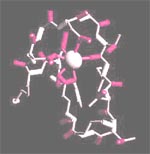Calcium equity within cells
 human cells are capable of identifying the areas within them that have higher concentrations of calcium. The implications of this research are that the cells are capable of equalising calcium levels in various cellular components.
human cells are capable of identifying the areas within them that have higher concentrations of calcium. The implications of this research are that the cells are capable of equalising calcium levels in various cellular components.
Calcium ion is a common means through which changes in the environment of a cell are communicated to the cell's interior. The primary change stimulates a receptor or sensor molecule on the cell's surface, and that, in turn, causes a change in the amount of calcium inside the cell. The changed calcium level leads to a further step of signalling. The first signal pulse rides on a calcium-binding protein known as calmodulin. It then reaches the nucleus. The final result is a specific response at the level of the dna . In other words, a gene is expressed or repressed.
It has been known for some time that the primary calcium change can occur in the nucleus in addition to the cell body or cytoplasm. Also, by selectively inhibiting any uptake of calcium from the cytoplasm to the nucleus, it is possible to show that the change in nuclear calcium conveys a message that is not the same as the one conveyed by a change in cytoplasmic calcium. How is this possible? How can a cell know whether the initial change has been in nuclear calcium or in cytoplasmic calcium? Mary N Teruel and colleagues at the Duke University Medical Centre of North Carolina, usa , have suggested an answer.
Working with tumour cells, they have shown that brief increases in cellular calcium caused changes in the level of a the calcium sensor calmodulin. These changes were markedly higher in the cytoplasm than in the nucleus. On the contrary, prolonged calcium increases led to an equalisation in calmodulin levels between cytoplasm and nucleus. The conclusion is that the calcium change may (or may not) lead to differences in cellular calmodulin levels within the cell ( Current Biology , Vol 10, No 2).
If there are such differences, calmodulin itself will diffuse from where it is at a higher level to where its level is lower. And, in turn, the ability of calmodulin to diffuse implies that the cell can regulate, at will, the concentration of calmodulin in the nucleus vis-
